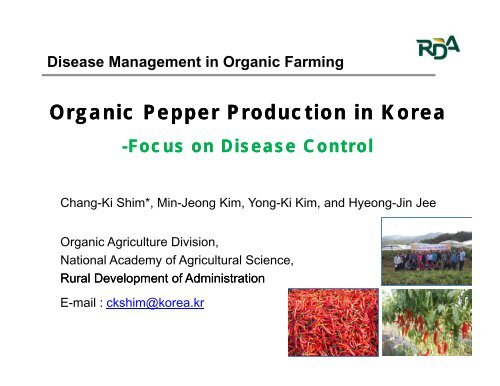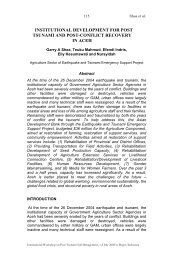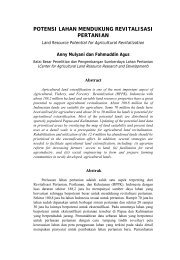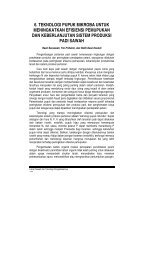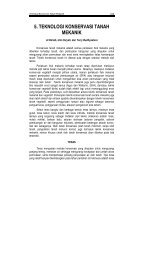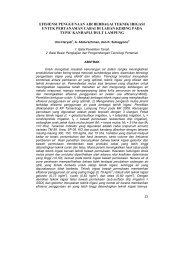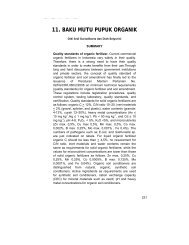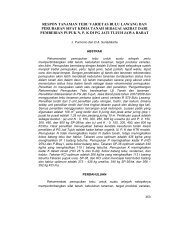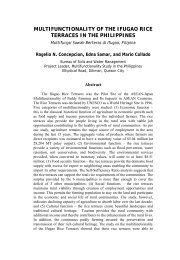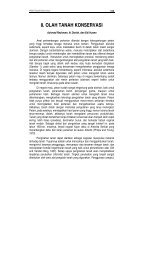Organic Pepper Production in Korea g pp g pp
Organic Pepper Production in Korea g pp g pp
Organic Pepper Production in Korea g pp g pp
You also want an ePaper? Increase the reach of your titles
YUMPU automatically turns print PDFs into web optimized ePapers that Google loves.
Disease Management <strong>in</strong> <strong>Organic</strong> Farm<strong>in</strong>g<br />
<strong>Organic</strong> g <strong>Pe<strong>pp</strong>er</strong> <strong>pp</strong> <strong>Production</strong> <strong>in</strong> <strong>Korea</strong><br />
-Focus Focus on Disease Control<br />
Chang-Ki Shim*, M<strong>in</strong>-Jeong Kim, Yong-Ki Kim, and Hyeong-J<strong>in</strong> Jee<br />
<strong>Organic</strong> Agriculture Division,<br />
National Academy y of Agricultural g Science, ,<br />
Rural Development of Adm<strong>in</strong>istration<br />
E-mail : ckshim@korea.kr
Contents<br />
Introduction<br />
Evaluation of Resistant cultivars<br />
Healthy Seedl<strong>in</strong>g of Hot pe<strong>pp</strong>er<br />
Soil and Nutrient Management<br />
Ra<strong>in</strong>proof Installation for Control of Anthracnose<br />
A<strong>pp</strong>lication of Friendly Environmental Materials
Overview of Domestic <strong>Organic</strong> Market<br />
Worldwide, <strong>Organic</strong> market rapidly grow<strong>in</strong>g about 20% : 160 countries 37.2 million ha<br />
Domestic organic land (30%↑), organic processed foods (23%↑)<br />
<strong>Organic</strong> food market size : 500 billion won<br />
- <strong>Organic</strong> agricultural products (46.6%), <strong>Organic</strong> processed foods (53.4%)<br />
<strong>Organic</strong> land : 1.0% of the total agricultural area <strong>in</strong> <strong>Korea</strong>(‘11)<br />
- low pesticides p 3.7%+ non pesticides p 4.7%+organic g 1.0%<br />
Percentage of processed foods : Import ratio 86.3%<br />
- Domestic materials (13.7%), Imported materials (71.6%), Imported processed foods (14.7%)<br />
(KREI, ’11)
Domestic <strong>Organic</strong> <strong>Pe<strong>pp</strong>er</strong> Cultivation<br />
Status of organic pe<strong>pp</strong>er cultivation<br />
Total organic farm<strong>in</strong>g area : Increas<strong>in</strong>g 3 times<br />
- 459 ha (2001)→ 13 13,376 376 ha (2011)<br />
<strong>Organic</strong> crop production :Increas<strong>in</strong>g3times<br />
- 797,747t(2005) → 2,215,521t(2010)<br />
<strong>Organic</strong> pe<strong>pp</strong>er farm<strong>in</strong>g : 0 7ha per farmer<br />
<strong>Organic</strong> pe<strong>pp</strong>er farm<strong>in</strong>g : 0.7ha per farmer<br />
- 231ha(2009) → 2,286ha (2011, 3 times↑)
Problems of <strong>Organic</strong> Farm<strong>in</strong>g <strong>in</strong> <strong>Korea</strong><br />
Crop rotation<br />
Live-stock rais<strong>in</strong>g Soil management g : Nutrients su<strong>pp</strong>ly <strong>pp</strong> y<br />
Cultivation<br />
Standardization<br />
of cultivation<br />
Rely on <strong>in</strong>put<br />
Pests management<br />
Cultural practice<br />
Crop protection<br />
Rotation<br />
(11 (11.9%) 9%)<br />
Diversity<br />
(19%)<br />
Home-made<br />
(16.7%)<br />
Biological<br />
(36%)<br />
Substance<br />
(27%)<br />
Over 46% farmers reported that the pest<br />
management is the major problem
Major diseases on pe<strong>pp</strong>er <strong>in</strong> <strong>Korea</strong><br />
The disease list on pe<strong>pp</strong>er (‘09, KSPP)<br />
Pathogen Number Target diseases<br />
Fungi 22 Phytophthora, Anthracnose, Powdery mildew<br />
Bacteria 7 Bacterial wilt, Soft rot<br />
Virus 16 CMV, PMMoV, BBWV-2, PVMV, etc,<br />
Total 45 *Above two diseases comprise about 80% yield loss<br />
Yield loss by the disease<br />
Yield loss : 50,000 M/T<br />
V Value l : >$300 $300 million illi<br />
Breed<strong>in</strong>g and cultivation technology is world top class !<br />
Export hot pe<strong>pp</strong>er seed : $7 million / year
Protective Disease Management<br />
Genetic diversity<br />
Resistant variety, barrier<br />
Crop rotation, cover crop<br />
Disease escape<br />
Soil health, Natural enemy<br />
Inter-, mix, perimeter cro<strong>pp</strong><strong>in</strong>g<br />
Micro-environmental conditions<br />
Solarization<br />
Heat, water management
1. Resistant cultivar : Phytophthora blight of pe<strong>pp</strong>er<br />
Resistant cultivar<br />
Resistant cultivar<br />
Susceptible cultivar<br />
Resistant cultivars with high<br />
yield and good quality are<br />
available s<strong>in</strong>ce 2004.<br />
Expected disease control<br />
efficacy is over 95%.<br />
At present, about 80% PR cv.<br />
are cultivated <strong>in</strong> <strong>Korea</strong>.
Evaluation Strategies of Resistant Cultivars<br />
Evaluation <strong>in</strong>dicator : Cultivation stability (12 items), Horticultural traits (5 items)<br />
Biotic and Abiotic resistance<br />
- Phytophthora blight, Anthracnose, Viral disease, Soft rot, Aphid, Tobacco Budworm,<br />
Calcium def<strong>in</strong>ition<br />
Cultivation stability<br />
- Yield Yield, Maturate stage stage, Plant type type, Plant Height Height, Dehiscent Fruit<br />
Horticultural traits<br />
- Moisture content, Dried fruit quality, Fruit taste, Fruit size, Fruit type, Fruit color<br />
Totally 47cutivars were screened <strong>in</strong> a greenhouse and <strong>in</strong> fields<br />
Greenhouse (‘06) Field (‘07) Field a<strong>pp</strong>lication (‘08)<br />
Selected 5 cultivars show<strong>in</strong>g various disease resistances
1-1. Phytophthora Resistant (PR) Cultivar<br />
Among 47 cultivars, Selected 5 cultivars show<strong>in</strong>g various disease resistances<br />
Cultivar<br />
Cultivation<br />
Stability<br />
2008 2009<br />
Horticultural<br />
trait<br />
Total<br />
Cultivation<br />
Stability<br />
Horticultural<br />
trait<br />
Total<br />
Total Total<br />
Score Rank<br />
PR Manita 59 28 87 63 27 90 177 1<br />
PR Daecheon 51 33 84 57 34 91 175 2<br />
Chenhatongil 40 36 76 56 36 92 168 3<br />
S<strong>in</strong>dogbuljanggun 46 29 75 59 33 92 167 5<br />
Sh<strong>in</strong>ogdongja 42 35 77 50 31 81 158 9<br />
Over 98% resistance to Phytophthora and moderate to others<br />
Good quality <strong>in</strong> fruit and high yield
2. Anthracnose pathogens of pe<strong>pp</strong>er<br />
Anthracnose disease caused by Colletotrichum species <strong>in</strong> <strong>Korea</strong><br />
Pathogen a oge Host os range a ge Infection ec o ssite e Symptom Sy p o Pathogenicity a oge c y Isolation so a o frequency eque cy<br />
Colletotrichum acutatum Broad Fruit Water-soak<strong>in</strong>g Strong +++<br />
C. cocodes Broad Seedl<strong>in</strong>g Damp<strong>in</strong>g off Week +<br />
C. dematium Broad Fruit Damp<strong>in</strong>g off Week +<br />
C. gloeosporioides Broad Fruit Damp<strong>in</strong>g off Week +
2-1. Resistant cultivar : Anthracnose of pe<strong>pp</strong>er<br />
Evaluation of anthracnose resistance of pe<strong>pp</strong>er breed<strong>in</strong>g l<strong>in</strong>e<br />
Breed<strong>in</strong>g l<strong>in</strong>e Infection rate (%) Degree Evaluation<br />
GP-12 72.2 ++ Moderate<br />
GP-23 75.0 ++ Moderate<br />
GP-45 100 +++ Susceptible<br />
GP-63 46.7 ++ Moderate<br />
GP-71 66.7 ++ Moderate<br />
GP-104 20.0 + Resistance<br />
GP-106 77.8 +++ Susceptible<br />
Selection of 21 of 209 accessions of anthracnose resistance <strong>in</strong> pe<strong>pp</strong>er germplasm<br />
resistance
3. Healthy seedl<strong>in</strong>g : Shoot Cutt<strong>in</strong>g Technique<br />
Promotion effect of Shoot cutt<strong>in</strong>g on lateral root formation of pe<strong>pp</strong>er seedl<strong>in</strong>g<br />
Conventional Shoot cutt<strong>in</strong>g method<br />
Sow<strong>in</strong>g Root cut off<br />
1 st leaf<br />
Shoot plant<strong>in</strong>g<br />
Saturated RH<br />
New lateral root<br />
Shade the light g<br />
Aux<strong>in</strong> stimulates the formation of<br />
adventitious roots <strong>in</strong> many species<br />
(Guerrero et al., 1999).<br />
Shoot cutt<strong>in</strong>gs to develop<br />
adventitious roots can vary by cultivar<br />
and successful root <strong>in</strong>duction with<br />
exogenous plant growth regulators<br />
may depend, <strong>in</strong> part, on endogenous<br />
hormone levels<br />
(Tworkoski and Takeda, 2007)
3-1. Promotion effect of shoot cutt<strong>in</strong>g on lateral root formation<br />
Promotion effect of Shoot cutt<strong>in</strong>g on lateral root formation of pe<strong>pp</strong>er<br />
Treatment Root fresh weight(g)<br />
Conventional 25.3e<br />
Control 34.8d<br />
0.2% Fulvic acid 41.1bc<br />
0.1% Fulvic acid 50.4a<br />
0.2% Humic soil 35.9d<br />
0.1% Humic soil 43.1b<br />
Effect of Shoot cutt<strong>in</strong>g on yield <strong>in</strong>cres<strong>in</strong>g of pe<strong>pp</strong>er<br />
Treatment<br />
Fruit<br />
length(cm)<br />
Fruit<br />
th<strong>in</strong>ckness(cm)<br />
Fruit fresh<br />
weight(g)<br />
Conventional 59.3d 0.9b 28.0d<br />
Control 66.0bc 1.6a 41.3bc<br />
0.2% Fulvic acid 63.3cd 1.7a 38.5bc<br />
0.1% Fulvic acid 68.7bc 1.7a 42.8b<br />
02%H 0.2% Humic i soil il 61 61.7cd d 11.5a 335.3c 3<br />
0.1% Humic soil 80.0a 1.7a 50.3a
4. Soil and Nutrient Management :Green manure<br />
Green manure a<strong>pp</strong>lied as organic fertilizer and rotation crop<br />
Sow<strong>in</strong>g : at October <strong>in</strong> 2011, 16 kg/10a →overw<strong>in</strong>ter<br />
Soil <strong>in</strong>corporation : hole plant <strong>in</strong>corporated at April <strong>in</strong> 2012<br />
- Rye grass : 5,445kg/10a (N-3%)<br />
- Hairy vetch : 3,069kg/10a (N-4%)<br />
Rye Hairy vetch Soil <strong>in</strong>corporation
4-1. Soil and Nutrient Management :Green manure<br />
Green manure a<strong>pp</strong>lied as organic fertilizer and rotation crop<br />
Fertilizer : Only green manure, no additional su<strong>pp</strong>lemental Nitrogen<br />
Growth and Yield Promotion effect on pe<strong>pp</strong>er<br />
- Rye grass : 1,710 kg/10a<br />
- Hairy vetch : 3,400kg/10a<br />
Rye grass<br />
Hairy vetch
5. Semi ra<strong>in</strong>-proof : break<strong>in</strong>g of anthracnose disease<br />
Epidemiological study on anthracnose pathogen<br />
Ra<strong>in</strong>fall Ra<strong>in</strong>fall, Airflow, Airflow W<strong>in</strong>d speed affects to the scatter<strong>in</strong>g distance of the spores<br />
Greenhouse (‘06) Field (‘07) Field a<strong>pp</strong>lication (‘08)
5-1. Semi ra<strong>in</strong>-proof : avoid<strong>in</strong>g ra<strong>in</strong> splash<br />
2009 Model<br />
2012 Model<br />
Effects of block<strong>in</strong>g ra<strong>in</strong> splash on control<br />
of f pe<strong>pp</strong>er anthracnose th by b CC. acutatum t t<br />
Effects of the semi ra<strong>in</strong> ra<strong>in</strong>-proof proof <strong>in</strong>stallation<br />
• Control : >98%<br />
• Cheaper than greenhouse<br />
• Yield : 125% • Easy to work<br />
• Income : 150% • Similar to field conditions<br />
• Labor : 50% - Air circulation circulation, light light, etc
Curative Disease Management<br />
Microbes<br />
Biochemicals<br />
Natural enemy<br />
Plant/animal orig<strong>in</strong>s<br />
Natural m<strong>in</strong>erals<br />
Cook<strong>in</strong>g oil & yolk mixture<br />
Microbial products<br />
<strong>Organic</strong> compost<br />
Others
6. Cook<strong>in</strong>g oil and yolk mixture (COY)<br />
Materials<br />
COY COY was was developed developed based based on on Dr. Dr. Ko’s Ko’s paper paper (Ko (Ko et. et. al. al. 2003) 2003)<br />
Amount of egg-yolk and cook<strong>in</strong>g oil for disease control<br />
Cook<strong>in</strong>g oil<br />
Egg-yolk<br />
Protective(0.3%) Curative(0.5%)<br />
20 ι 500 ι 20 ι 500 ι<br />
60ml<br />
1<br />
1.5 ι<br />
15<br />
100ml<br />
1<br />
2.5 ι<br />
15
6-1. Mechanism study on COY<br />
Direct : Destroy mycelial wall, disturb respiration and<br />
lipid metabolisms of <strong>in</strong>sect.<br />
Indirect : Repellent <strong>in</strong>sects, coat<strong>in</strong>g plant surface to protect<br />
from germ<strong>in</strong>ation and <strong>in</strong>fection of pathogens.<br />
Active mycelia<br />
before treatment<br />
Destroyed mycelia<br />
After treatment<br />
COY<br />
Comparison of powdery mildew on treated<br />
lower leaves and non-treated u<strong>pp</strong>er leaves<br />
of cucumber with canola COY 0.3%.
6-2. Effect of COY mixture on Insect pest and<br />
Diseases<br />
COY mixture with other su<strong>pp</strong>lement<br />
Crops Target pests COY+(su<strong>pp</strong>lement)<br />
COY COYM<br />
<strong>Pe<strong>pp</strong>er</strong><br />
Paprika<br />
Anthracnose<br />
Ca 200<strong>pp</strong>m: egg shell extract<br />
30.5 68.0<br />
(7 ( fields) ) Bordeaux 500x, , co<strong>pp</strong>er, <strong>pp</strong> , sulfur<br />
Powdery mildew 91.6 96.2 Ca 200<strong>pp</strong>m, Sulfur ½<br />
Aphid 62.4 94.4 Ca 200<strong>pp</strong>m, Neem ½<br />
Mite 98.1 99.4 Ca 200<strong>pp</strong>m, <strong>pp</strong> , Neem ½
7-1. Control effect of pH adjusted Loess Sulfur mixture<br />
on Powdery mildew of <strong>Pe<strong>pp</strong>er</strong><br />
Control effect of 0.2% Loess Sulfur mixture<br />
Treatment<br />
Powdery mildew of pe<strong>pp</strong>er (%)<br />
7 DAT Control value 14 DAT Control value<br />
Control 45 45.3c 3c - 82 82.4c 4c<br />
-<br />
0.5% COY+Cu 13.1b 71.1 11.2b 86.4<br />
0.2% Lime Sulfur mixture 8.2a 82.2 7.2a 91.3<br />
0.2% Loess Sulfur mixture 1) 4.9a 88.9 5.1a 93.8<br />
1) : pH adjusted with brown rice v<strong>in</strong>egar (30ml /20L f<strong>in</strong>al volume)
7. Effect of pH adjusted Loess Sulfur mixture<br />
on Foliar Diseases<br />
Components of Loess Sulfur mixture<br />
Sulfur NaOH Loess Salt Phyllite y<br />
Egg shell<br />
calciium l ii<br />
Water pH p<br />
Farm 25kg 20kg 0.5kg 1.5kg 0.5kg 0.5kg 100L 12.7<br />
RDA 25kg 15kg 0.5kg 1.5kg 0.5kg 0.5kg 105L 11.7<br />
pH of Loess Sulfur mixture adjusted with brown rice v<strong>in</strong>egar<br />
pH<br />
Control effect<br />
Phytotoxicity<br />
Powdery mildew(%) Shoot leaf<br />
5.2 55d - -<br />
7.2 75c - -<br />
7.5 75c - -<br />
78 7.8 85b - -<br />
8.5 95a - -<br />
10.9 95a - -<br />
11.0 85b ++ ++
Conclusion<br />
Cornerstones of Plant Protection <strong>in</strong> <strong>Organic</strong> <strong>Pe<strong>pp</strong>er</strong> Farm<strong>in</strong>g<br />
(Before) )<br />
Prrotective<br />
Ecological<br />
means<br />
Physical<br />
methods<br />
Cultural Biological<br />
practice agents g<br />
<strong>Organic</strong><br />
Plant Protection<br />
Crop<br />
rotation<br />
Resistant var.<br />
Health seed<br />
Natural<br />
substances<br />
Commercial<br />
products<br />
Curative<br />
(AAfter)
<strong>Organic</strong> farm<strong>in</strong>g is not far away<br />
Thank you<br />
for for your attention!


